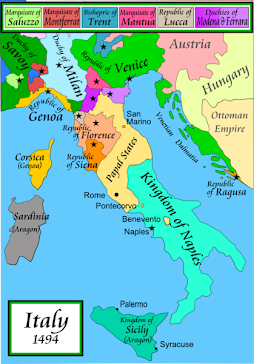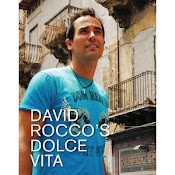Italian Cuisine Throughout the Ages

It never fails. Visit any culinary website and you'll find that Italian cuisine usually ranks in the top three to five on grounds of popularity. That’s not too shabby considering that there are 196 countries worldwide. It's taken several centuries, as well as the infiltration of other cultural influences, to establish what we now know as modern day Italian cooking. Its notoriety on a global scale is so profound that even the Japanese have a modified version on their menus…Sushi Pizza, anyone?
Italian food conjures up warm visions of cheesy pizza and spaghetti swimming in a pool of tomato sauce. Irrespective of this stereotype we all know there is more to the art of Italian gastronomy. Due to Italy’s vast peasant population it was widely known as la cucina povera, the poor man’s cuisine. Its complex origins lie within the merchant trade of the Mediterranean, the Middle East and Asia, the rise of the Roman Empire, the Barbarian invasions of Europe and the golden age of exploration.
The earliest Italian cookbooks were written in the latter part of the Middle Ages. What would they have consisted of back then? If culinary enthusiast, David Rocco lived in the early 13th century his Italian cookbook would list very different recipes than his modern day version. There wouldn’t be any Penne Arrabiata, Polenta alla Gorgonzola, Lasagne or Gnocchi di Patate, just to name a few. Reason being, many of the staple items that are now used in kitchens and restaurants all over Italy were not yet introduced. In order to understand we have to go back in time.
Italian food conjures up warm visions of cheesy pizza and spaghetti swimming in a pool of tomato sauce. Irrespective of this stereotype we all know there is more to the art of Italian gastronomy. Due to Italy’s vast peasant population it was widely known as la cucina povera, the poor man’s cuisine. Its complex origins lie within the merchant trade of the Mediterranean, the Middle East and Asia, the rise of the Roman Empire, the Barbarian invasions of Europe and the golden age of exploration.
The earliest Italian cookbooks were written in the latter part of the Middle Ages. What would they have consisted of back then? If culinary enthusiast, David Rocco lived in the early 13th century his Italian cookbook would list very different recipes than his modern day version. There wouldn’t be any Penne Arrabiata, Polenta alla Gorgonzola, Lasagne or Gnocchi di Patate, just to name a few. Reason being, many of the staple items that are now used in kitchens and restaurants all over Italy were not yet introduced. In order to understand we have to go back in time.
Italian City-States and Principalities

Italy’s rich and tumultuous history has played a key role in its culinary success. The Romans are accredited for bringing the olive tree to Italy from Turkey around 600 B.C. They also acquired the art of winemaking from the Greeks, mastering it by bottling and aging the must. This popular beverage over time became a staple of the Roman diet. The expansion of the Empire led to increased foreign trade and as a result, many novelty items for its citizens to sample. The Romans satisfied their sweet tooth by reinventing the Egyptian treat, ice cream. Market squares selling baskets of dates from North Africa and unusual spices, such as Persian saffron must have been popular destinations for the local people.
Italy’s geographical location made it ideal for trade but also made it a target for unwelcome invaders from other lands. Without Rome’s protection, proceeding the fall of the Empire around 400 A.D., the peninsula became a free for all. During this time until the Unification in 1861, Italy was slowly being divided into city states or principalities. Each area maintained the culinary customs introduced by these new occupants. The predominant peasant population travelled only a few kilometers from their villages throughout the course of their lifetime. Therefore, traditions were maintained for centuries. Northern Italian cuisine had a Roman and Germanic predominance while the south was mostly influenced by the Moors of North Africa and the Spaniards. Upon the Arabic conquest of Sicily in the 6th and 7th centuries, an array of new foods such as the eggplant, coffee, almonds and the art of making Marzipan, were introduced. Although the Spaniards infiltrated most of the south, they also ruled over Milan for a time in the 17th century. With them they brought rice and saffron for Paella which then became the legendary, Risotto alla Milanese. Merchant and explorer, Marco Polo, brought modern day pasta from his travels in China and described it as ‘a type ofLagane’. Lagane, the precursor of Lasagne, was a dish comprised of meat in between layers of thick dough. In northern Italy nutmeg, clove and cinnamon are traditional spices due to Slavic and Germanic occupation. If one good thing came from these invasions it was the introduction of foodstuffs that are now known as Italian staples.
Then along came the explorers. With the quest to further trade and obtain more global real estate, Europeans began circling the world. Upon their return they introduced many fruits, vegetables and meats that were seen with skepticism and fear. People thought many of these items, such as the tomato, were poisonous. This particular fruit made its grand entrance into European palaces and homesteads via the Spaniards on Christopher Columbus’ return voyage from the Americas in 1493. We can ultimately thank Marco and Christopher for pasta with tomato sauce!
The potato, another American novelty, was responsible for the 19th century European population boom. It was climate-friendly, easy to grow and inexpensive. In Friuli and Carnia the tradition of making potato gnocchi takes on a different twist by adding a sauce of golden butter and cinnamon, unlike the more popular version found in Naples, consisting of tomato. We can not forget that Signor Columbus was also responsible for importing hot chilies which he referred to as pepper because this ingredient, like actual pepper, could be added to food in order to accentuate flavour.
As anyone can see, Italy’s rich and diverse traditional cuisine has morphed over centuries. In the last 200 years tourism to the country, vast emigration and modern day multi-media have assisted in its success. Judging by its sustainability and world wide appeal, Italian cooking will continue to top the charts for many years to come. Buon Appetito!
Italy’s geographical location made it ideal for trade but also made it a target for unwelcome invaders from other lands. Without Rome’s protection, proceeding the fall of the Empire around 400 A.D., the peninsula became a free for all. During this time until the Unification in 1861, Italy was slowly being divided into city states or principalities. Each area maintained the culinary customs introduced by these new occupants. The predominant peasant population travelled only a few kilometers from their villages throughout the course of their lifetime. Therefore, traditions were maintained for centuries. Northern Italian cuisine had a Roman and Germanic predominance while the south was mostly influenced by the Moors of North Africa and the Spaniards. Upon the Arabic conquest of Sicily in the 6th and 7th centuries, an array of new foods such as the eggplant, coffee, almonds and the art of making Marzipan, were introduced. Although the Spaniards infiltrated most of the south, they also ruled over Milan for a time in the 17th century. With them they brought rice and saffron for Paella which then became the legendary, Risotto alla Milanese. Merchant and explorer, Marco Polo, brought modern day pasta from his travels in China and described it as ‘a type ofLagane’. Lagane, the precursor of Lasagne, was a dish comprised of meat in between layers of thick dough. In northern Italy nutmeg, clove and cinnamon are traditional spices due to Slavic and Germanic occupation. If one good thing came from these invasions it was the introduction of foodstuffs that are now known as Italian staples.
Then along came the explorers. With the quest to further trade and obtain more global real estate, Europeans began circling the world. Upon their return they introduced many fruits, vegetables and meats that were seen with skepticism and fear. People thought many of these items, such as the tomato, were poisonous. This particular fruit made its grand entrance into European palaces and homesteads via the Spaniards on Christopher Columbus’ return voyage from the Americas in 1493. We can ultimately thank Marco and Christopher for pasta with tomato sauce!
The potato, another American novelty, was responsible for the 19th century European population boom. It was climate-friendly, easy to grow and inexpensive. In Friuli and Carnia the tradition of making potato gnocchi takes on a different twist by adding a sauce of golden butter and cinnamon, unlike the more popular version found in Naples, consisting of tomato. We can not forget that Signor Columbus was also responsible for importing hot chilies which he referred to as pepper because this ingredient, like actual pepper, could be added to food in order to accentuate flavour.
As anyone can see, Italy’s rich and diverse traditional cuisine has morphed over centuries. In the last 200 years tourism to the country, vast emigration and modern day multi-media have assisted in its success. Judging by its sustainability and world wide appeal, Italian cooking will continue to top the charts for many years to come. Buon Appetito!
Barbarian Influences in Italy


David Rocco's 'Dolce VIta'

Catch David on the TLN Network, weeknights at 11:30pm EST

Culinary
Arts and Culture
Restaurant Reviews
People
About Me
Sunday 5 February 2012
Subscribe to:
Posts (Atom)
